Iron(II) Complexes with Porphyrin and Tetrabenzoporphyrin: CASSCF/MCQDPT2 Study of the Electronic Structures and UV–Vis Spectra by sTD-DFT
Abstract
1. Introduction
2. Computational Details
3. Results and Discussion
3.1. Electronic Structure
3.2. Geometry Structure and Analysis of Electronic Density Distribution
3.3. Electronic Absorption Spectra
4. Conclusions
Supplementary Materials
Author Contributions
Funding
Institutional Review Board Statement
Informed Consent Statement
Data Availability Statement
Acknowledgments
Conflicts of Interest
References
- Kobayashi, H.; Yanagawa, Y. Electronic Spectra and Electronic Structure of Iron(II) Tetraphenylporphins. Bull. Chem. Soc. Jpn. 1972, 45, 450–456. [Google Scholar] [CrossRef]
- Xinhua, Z.; Jiesheng, H.; Panwen, S.; Yaoyu, F. A New Method of Preparation of Iron(II) Porphyrin Complexes—Isolation and Characterization of Amine Complexes of Ferrous Porphyrin. Polyhedron 1996, 15, 2677–2679. [Google Scholar] [CrossRef]
- Huszánk, R.; Horváth, O. A Heme-like, Water-Soluble Iron (II) Porphyrin: Thermal and Photoinduced Properties, Evidence for Sitting-atop Structure. Chem. Commun. 2005, 2, 224–226. [Google Scholar] [CrossRef] [PubMed]
- Barona-Castaño, J.; Carmona-Vargas, C.; Brocksom, T.; de Oliveira, K. Porphyrins as Catalysts in Scalable Organic Reactions. Molecules 2016, 21, 310. [Google Scholar] [CrossRef] [PubMed]
- Zhang, T.T.; Liu, Y.D.; Zhong, R.G. Iron(II) Porphyrins Induced Conversion of Nitrite into Nitric Oxide: A Computational Study. J. Inorg. Biochem. 2015, 150, 126–132. [Google Scholar] [CrossRef]
- Mondal, B.; Sen, P.; Rana, A.; Saha, D.; Das, P.; Dey, A. Reduction of CO2 to CO by an Iron Porphyrin Catalyst in the Presence of Oxygen. ACS Catal. 2019, 9, 3895–3899. [Google Scholar] [CrossRef]
- Darmokoesoemo, H.; Setyawati, H.; Kris Murwani, I.; Irfan, M.; Adhitiya, L.; Dania Audria Ulfa, A.; Fuadi Prasetia, R. Green Light Harvester by Porphyrin Derivative Complexes: The Influence of Metal in Photovoltaic on Dye-Sensitized Solar Cells. Results Chem. 2022, 4, 100646. [Google Scholar] [CrossRef]
- Arruda, L.M.; Ali, M.E.; Bernien, M.; Nickel, F.; Kopprasch, J.; Czekelius, C.; Oppeneer, P.M.; Kuch, W. Modifying the Magnetic Anisotropy of an Iron Porphyrin Molecule by an On-Surface Ring-Closure Reaction. J. Phys. Chem. C 2019, 123, 14547–14555. [Google Scholar] [CrossRef]
- Heinrich, B.W.; Ahmadi, G.; Müller, V.L.; Braun, L.; Pascual, J.I.; Franke, K.J. Change of the Magnetic Coupling of a Metal–Organic Complex with the Substrate by a Stepwise Ligand Reaction. Nano Lett. 2013, 13, 4840–4843. [Google Scholar] [CrossRef]
- Kobayashi, N.; Koshiyama, M.; Osa, T. (TETRABENZPORPHINATO)IRON. Chem. Lett. 1983, 12, 163–166. [Google Scholar] [CrossRef]
- Weigend, F.; Ahlrichs, R. Balanced Basis Sets of Split Valence, Triple Zeta Valence and Quadruple Zeta Valence Quality for H to Rn: Design and Assessment of Accuracy. Phys. Chem. Chem. Phys. 2005, 7, 3297–3305. [Google Scholar] [CrossRef]
- Feller, D. The Role of Databases in Support of Computational Chemistry Calculations. J. Comput. Chem. 1996, 17, 1571–1586. [Google Scholar] [CrossRef]
- Schuchardt, K.L.; Didier, B.T.; Elsethagen, T.; Sun, L.; Gurumoorthi, V.; Chase, J.; Li, J.; Windus, T.L. Basis Set Exchange: A Community Database for Computational Sciences. J. Chem. Inf. Model. 2007, 47, 1045–1052. [Google Scholar] [CrossRef]
- Pritchard, B.P.; Altarawy, D.; Didier, B.; Gibson, T.D.; Windus, T.L. New Basis Set Exchange: An Open, Up-to-Date Resource for the Molecular Sciences Community. J. Chem. Inf. Model. 2019, 59, 4814–4820. [Google Scholar] [CrossRef]
- Alex, A. Granovsky Firefly Version 8. Available online: http://classic.chem.msu.su/gran/gamess/index.html (accessed on 15 April 2021).
- Schmidt, M.W.; Baldridge, K.K.; Boatz, J.A.; Elbert, S.T.; Gordon, M.S.; Jensen, J.H.; Koseki, S.; Matsunaga, N.; Nguyen, K.A.; Su, S.; et al. General Atomic and Molecular Electronic Structure System. J. Comput. Chem. 1993, 14, 1347–1363. [Google Scholar] [CrossRef]
- Zhurko, G.A.; Zhurko, D.A. ChemCraft Version 1.6 (Build 312); Version 1.6 (Build 312) Ed. Available online: http://www.chemcraftprog.com/index.html (accessed on 1 December 2022).
- Bannwarth, C.; Grimme, S. A Simplified Time-Dependent Density Functional Theory Approach for Electronic Ultraviolet and Circular Dichroism Spectra of Very Large Molecules. Comput. Theor. Chem. 2014, 1040–1041, 45–53. [Google Scholar] [CrossRef]
- Neese, F. The ORCA Program System. Wiley Interdiscip. Rev. Comput. Mol. Sci. 2012, 2, 73–78. [Google Scholar] [CrossRef]
- Neese, F. Software Update: The ORCA Program System—Version 5.0. WIREs Comput. Mol. Sci. 2022, 12, e1606. [Google Scholar] [CrossRef]
- Yanai, T.; Tew, D.P.; Handy, N.C. A New Hybrid Exchange-Correlation Functional Using the Coulomb-Attenuating Method (CAM-B3LYP). Chem. Phys. Lett. 2004, 393, 51–57. [Google Scholar] [CrossRef]
- Weigend, F. Accurate Coulomb-Fitting Basis Sets for H to Rn. Phys. Chem. Chem. Phys. 2006, 8, 1057–1065. [Google Scholar] [CrossRef]
- Neese, F.; Wennmohs, F.; Hansen, A.; Becker, U. Efficient, Approximate and Parallel Hartree-Fock and Hybrid DFT Calculations. A “chain-of-Spheres” Algorithm for the Hartree-Fock Exchange. Chem. Phys. 2009, 356, 98–109. [Google Scholar] [CrossRef]
- Marenich, A.V.; Cramer, C.J.; Truhlar, D.G. Universal Solvation Model Based on Solute Electron Density and on a Continuum Model of the Solvent Defined by the Bulk Dielectric Constant and Atomic Surface Tensions. J. Phys. Chem. B 2009, 113, 6378–6396. [Google Scholar] [CrossRef] [PubMed]
- Lu, T.; Chen, F. Multiwfn: A Multifunctional Wavefunction Analyzer. J. Comput. Chem. 2012, 33, 580–592. [Google Scholar] [CrossRef] [PubMed]
- Zhabanov, Y.A.; Sliznev, V.V.; Ryzhov, I.V.; Stuzhin, P.A. Peculiarities of Electronic Structure and Chemical Bonding in Iron and Cobalt Metal Complexes of Porphyrazine and Tetra(1,2,5-Thiadiazole)Porphyrazine. J. Porphyr. Phthalocyanines 2020, 24, 1146–1154. [Google Scholar] [CrossRef]
- Grimme, S.; Antony, J.; Ehrlich, S.; Krieg, H. A Consistent and Accurate Ab Initio Parametrization of Density Functional Dispersion Correction (DFT-D) for the 94 Elements H-Pu. J. Chem. Phys. 2010, 132, 154104. [Google Scholar] [CrossRef] [PubMed]
- Eroshin, A.V.; Otlyotov, A.A.; Kuzmin, I.A.; Stuzhin, P.A.; Zhabanov, Y.A. DFT Study of the Molecular and Electronic Structure of Metal-Free Tetrabenzoporphyrin and Its Metal Complexes with Zn, Cd, Al, Ga, In. Int. J. Mol. Sci. 2022, 23, 939. [Google Scholar] [CrossRef]
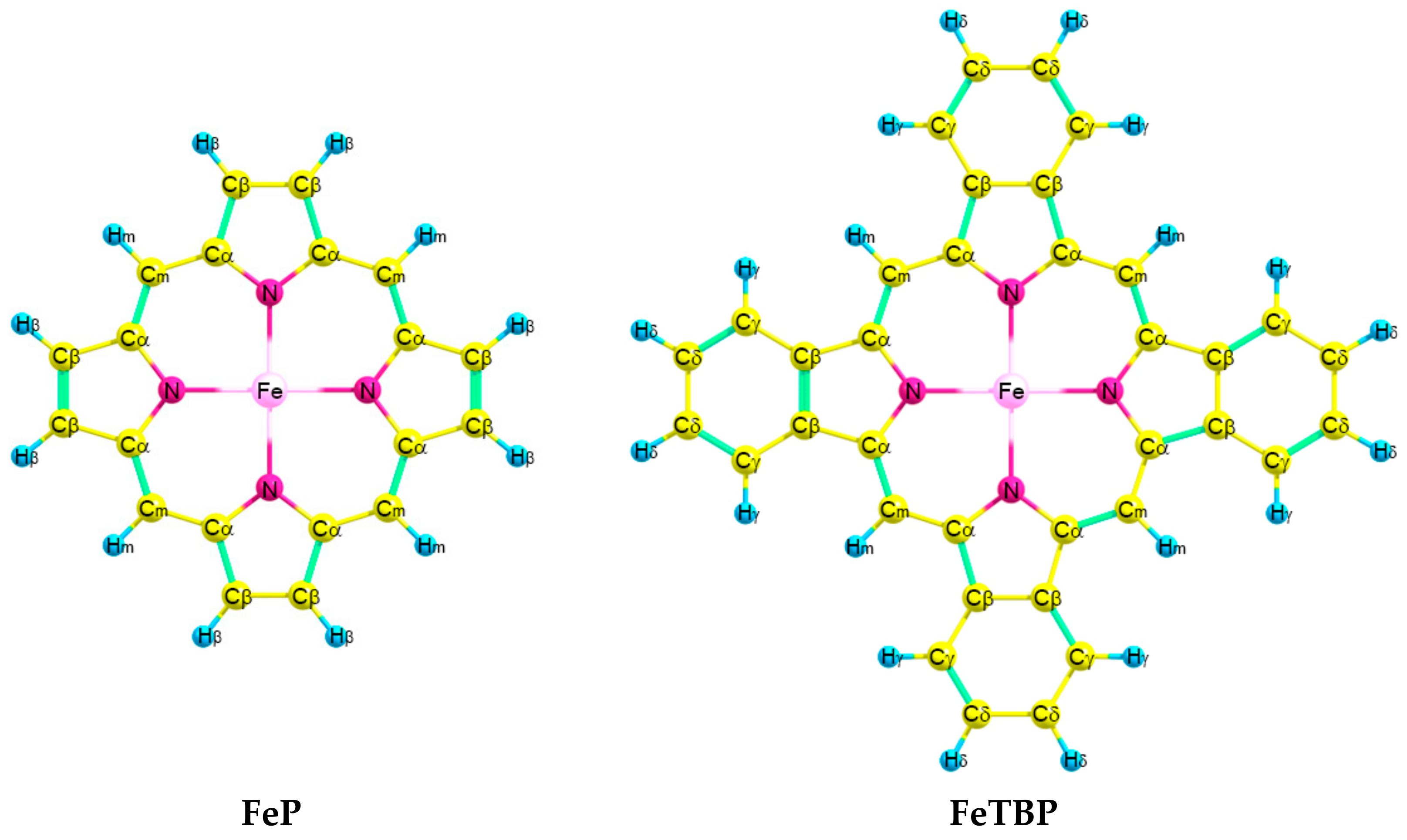
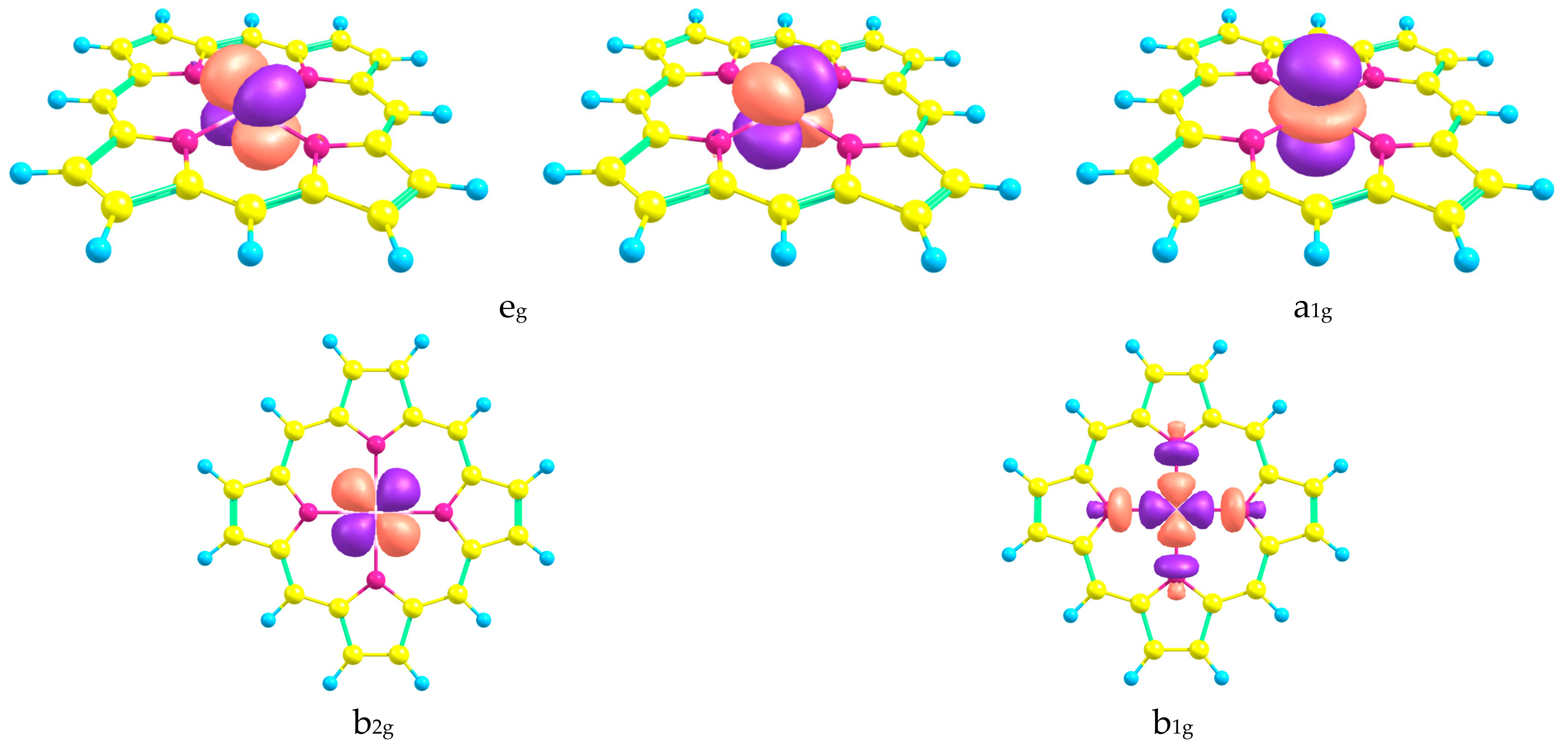
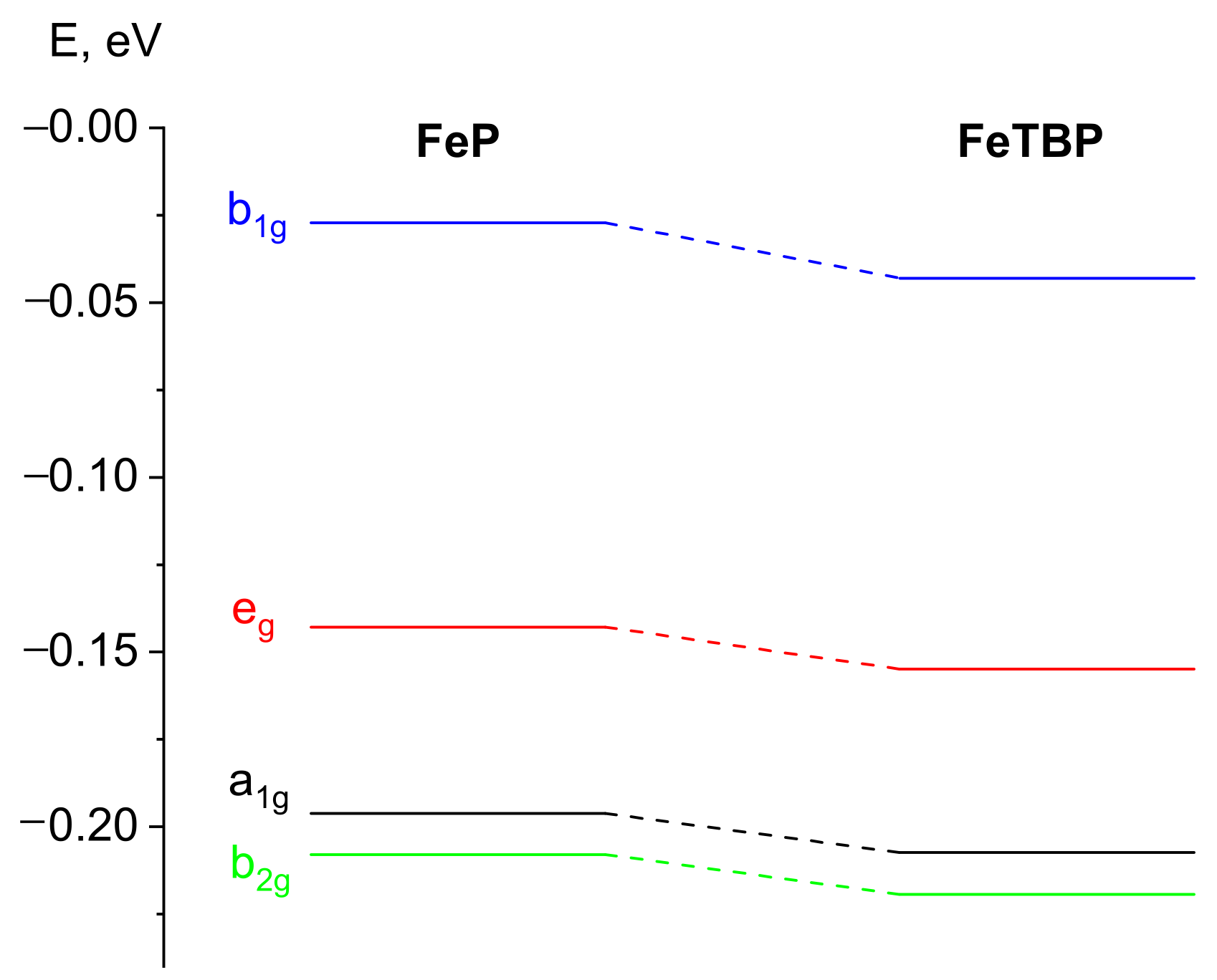

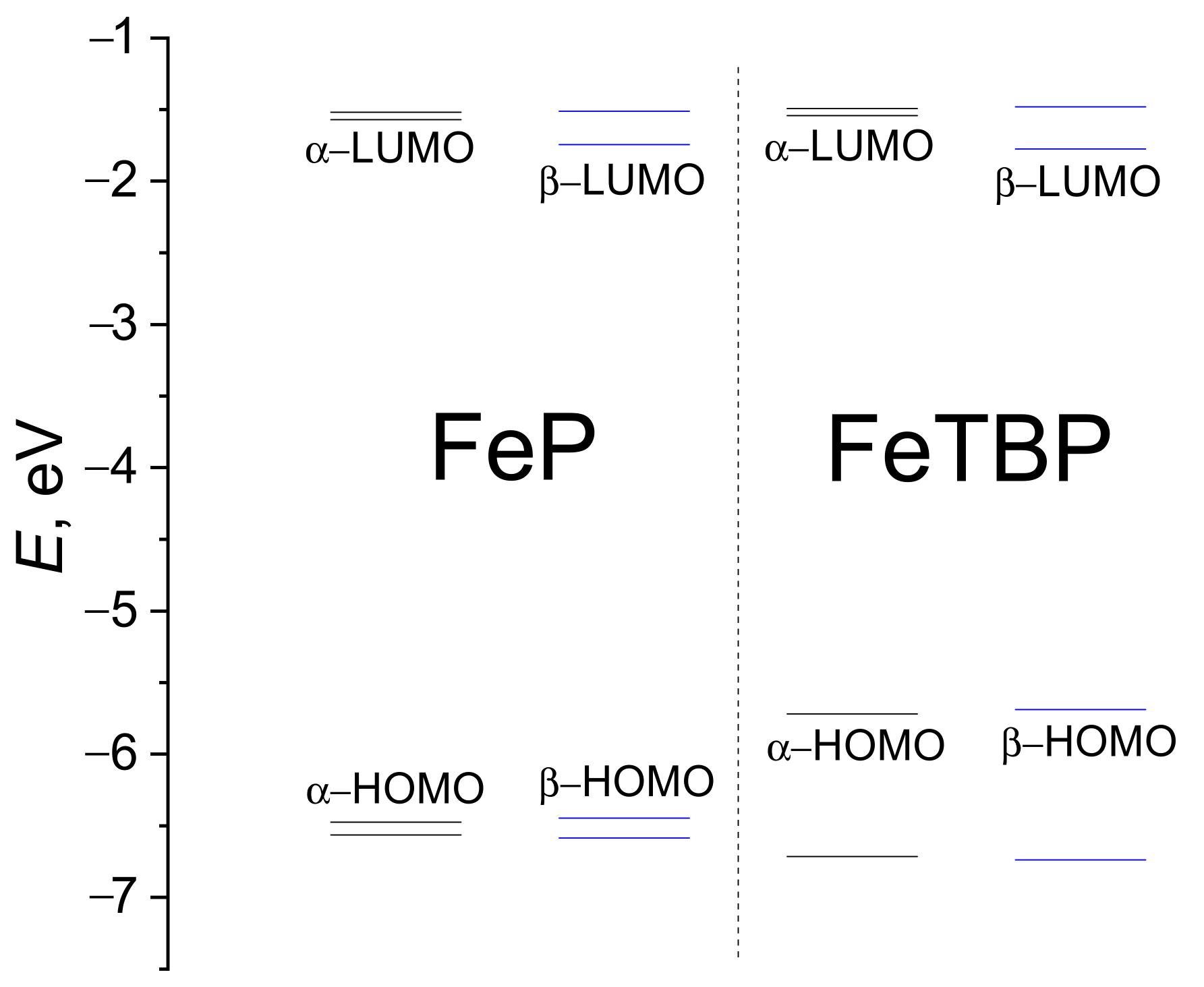
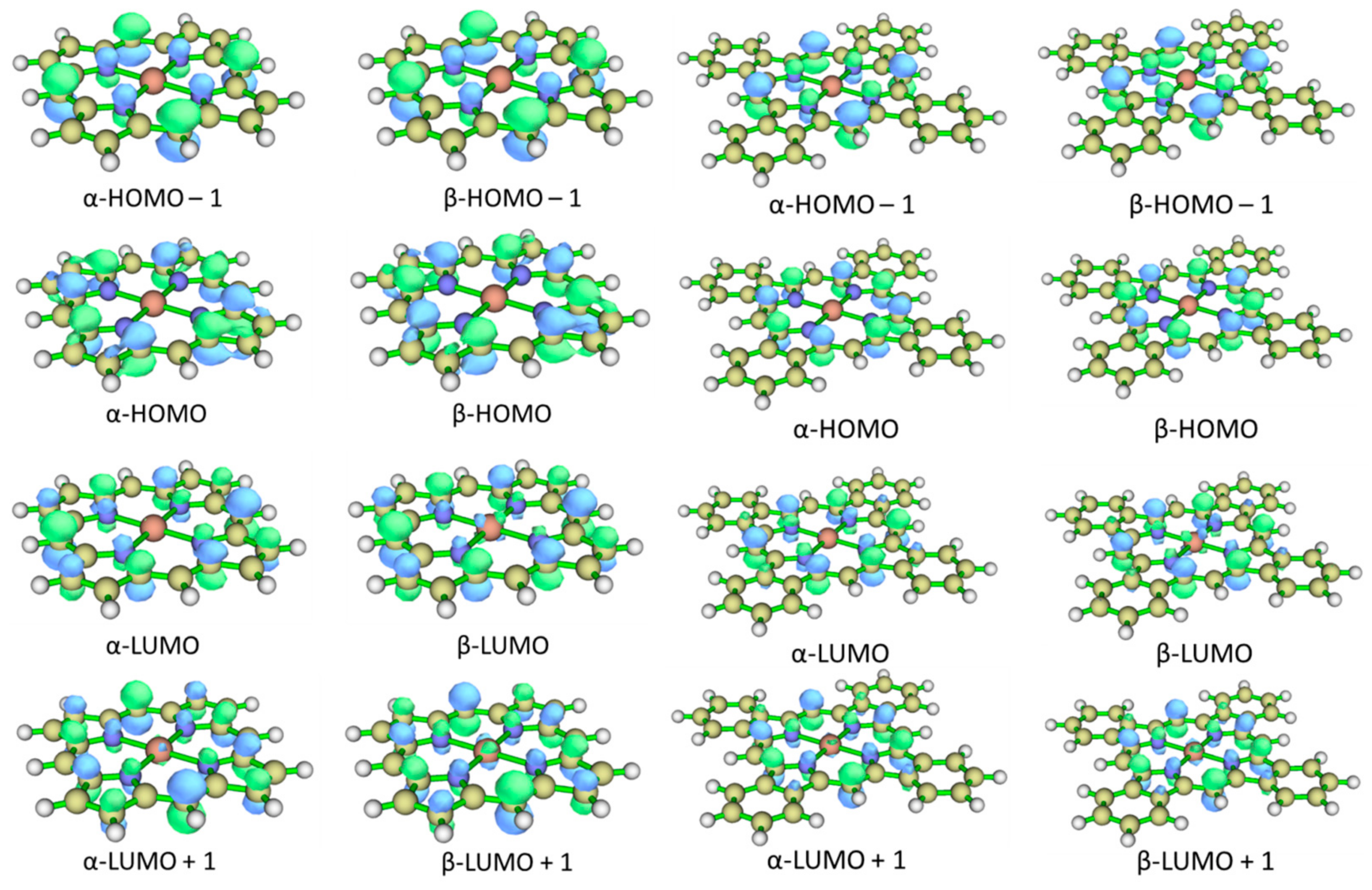
| State | ΔE, kJ/mol | State | ΔE, kJ/mol | State | ΔE kJ/mol | State | ΔE, kJ/mol |
|---|---|---|---|---|---|---|---|
| FeP | FeTBP | FeP | FeTBP | ||||
| 1B1g | 107.5 | 1B1g | 119.0 | 3A2g | 0 | 3A2g | 0 |
| 1B2g | 107.5 | 1B2g | 120.6 | 3Eg | 15.8 | 3Eg | 11.1 |
| 1Eg | 116.2 | 1A1g | 120.6 | 3B2g | 79.8 | 3B2g | 71.5 |
| 1A1g | 117.1 | 1Eg | 123.1 | 3Eg | 137.7 | 3Eg | 132.6 |
| 1A1g | 186.1 | 1A1g | 194.6 | 3B1g | 264.1 | 3B1g | 249.1 |
| 1B2g | 220.2 | 1B2g | 224.1 | 3B1g | 275.7 | 3Eg | 258.6 |
| 1Eg | 232.6 | 1Eg | 239.2 | 3Eg | 275.8 | 3B1g | 259.7 |
| 1A1g | 363.3 | 1B1g | 348.1 | 3B2g | 282.1 | 3B2g | 266.1 |
| 1B1g | 367.5 | 1A1g | 351.1 | 3A2g | 284.0 | 3A2g | 267.0 |
| 1B2g | 381.2 | 1Eg | 357.7 | ||||
| 1Eg | 382.5 | 5A1g | 23.9 | 5A1g | 8.5 | ||
| 5Eg | 46.0 | 5Eg | 26.7 | ||||
| 5B2g | 59.8 | 5B2g | 42.8 | ||||
| 5B1g | 290.6 | 5B1g | 261.8 | ||||
| FeP | FeTBP | |||
|---|---|---|---|---|
| 3A2g | 5A1g | 3A2g | 5A1g | |
| Distances | ||||
| r(M–N) | 1.990 | 2.054 | 2.014 | 2.077 |
| r(N–Cα) | 1.366 | 1.361 | 1.367 | 1.362 |
| r(Cα–Cβ) | 1.432 | 1.438 | 1.442 | 1.447 |
| r(Cα–Cm) | 1.380 | 1.392 | 1.375 | 1.386 |
| r(Cβ–Cβ) | 1.354 | 1.357 | 1.397 | 1.402 |
| r(Cβ–Cγ) | - | - | 1.393 | 1.392 |
| r(Cγ–Cδ) | - | - | 1.380 | 1.381 |
| r(Cδ–Cδ) | - | - | 1.402 | 1.401 |
| r(N…N)opp | 3.980 | 4.108 | 4.028 | 4.154 |
| r(N…N)adj | 2.814 | 2.905 | 2.848 | 2.937 |
| r(Cm–Cm)opp | 6.800 | 6.835 | 6.810 | 6.843 |
| r(Cm–Cm)adj | 4.809 | 4.833 | 4.815 | 4.839 |
| P a | 21.967 | 22.020 | 21.932 | 21.982 |
| Angles | ||||
| ∠(NCαCm) | 125.4 | 125.2 | 125.7 | 125.6 |
| ∠(CαCmCα) | 125.4 | 127.1 | 125.6 | 127.8 |
| ∠(CαNCα) | 105.5 | 107.5 | 107.0 | 108.9 |
| ΔE | 0 | 38.4 | 7.1 | 0 |
| FeP | FeTBP | |||
|---|---|---|---|---|
| 3A2g | 5A1g | 3A2g | 5A1g | |
| N | −1.202 | −1.254 | −1.198 | −1.249 |
| Cα | +0.438 | +0.448 | +0.438 | +0.448 |
| Cβ | −0.061 | −0.063 | −0.027 | −0.028 |
| Hβ | +0.063 | +0.062 | – | – |
| Cm | −0.025 | −0.033 | −0.015 | −0.024 |
| Hm | +0.052 | +0.051 | +0.045 | +0.044 |
| Fe | +1.186 | +1.355 | +1.192 | +1.360 |
| Cγ | – | – | −0.027 | −0.027 |
| Hγ | – | – | +0.042 | +0.043 |
| Cδ | – | – | −0.034 | −0.034 |
| Hδ | – | – | +0.043 | +0.043 |
| λ, nm | f | Composition (%) |
|---|---|---|
| FeP | ||
| 372.1 | 1.28 | α-HOMO → α-LUMO + 1 (27) α-HOMO—1 → α-LUMO (25) β-HOMO → β-LUMO + 1 (25) |
| 364.8 | 1.33 | β-HOMO—1 → β-LUMO + 1 (29) α-HOMO—1 → α-LUMO + 1 (28) α-HOMO → α-LUMO (22) |
| FeTBP | ||
| 646.5 | 0.27 | α-HOMO → α-LUMO (64) β-HOMO → β-LUMO (23) α-HOMO—1 → α-LUMO + 1 (7) |
| 622.0 | 0.21 | α-HOMO → α-LUMO + 1 (42) β-HOMO → β-LUMO + 1 (35) β-HOMO—1 → β-LUMO (17) |
| 401.2 | 1.38 | α-HOMO—1→ α-LUMO (51) β-HOMO—1 → β-LUMO (26) α-HOMO → α-LUMO + 1 (9) |
| 383.3 | 1.18 | β-HOMO—1 → β-LUMO + 1 (41) α-HOMO—1→ α-LUMO + 1 (38) α-HOMO → α-LUMO (7) |
Disclaimer/Publisher’s Note: The statements, opinions and data contained in all publications are solely those of the individual author(s) and contributor(s) and not of MDPI and/or the editor(s). MDPI and/or the editor(s) disclaim responsibility for any injury to people or property resulting from any ideas, methods, instructions or products referred to in the content. |
© 2023 by the authors. Licensee MDPI, Basel, Switzerland. This article is an open access article distributed under the terms and conditions of the Creative Commons Attribution (CC BY) license (https://creativecommons.org/licenses/by/4.0/).
Share and Cite
Eroshin, A.V.; Koptyaev, A.I.; Otlyotov, A.A.; Minenkov, Y.; Zhabanov, Y.A. Iron(II) Complexes with Porphyrin and Tetrabenzoporphyrin: CASSCF/MCQDPT2 Study of the Electronic Structures and UV–Vis Spectra by sTD-DFT. Int. J. Mol. Sci. 2023, 24, 7070. https://doi.org/10.3390/ijms24087070
Eroshin AV, Koptyaev AI, Otlyotov AA, Minenkov Y, Zhabanov YA. Iron(II) Complexes with Porphyrin and Tetrabenzoporphyrin: CASSCF/MCQDPT2 Study of the Electronic Structures and UV–Vis Spectra by sTD-DFT. International Journal of Molecular Sciences. 2023; 24(8):7070. https://doi.org/10.3390/ijms24087070
Chicago/Turabian StyleEroshin, Alexey V., Andrey I. Koptyaev, Arseniy A. Otlyotov, Yury Minenkov, and Yuriy A. Zhabanov. 2023. "Iron(II) Complexes with Porphyrin and Tetrabenzoporphyrin: CASSCF/MCQDPT2 Study of the Electronic Structures and UV–Vis Spectra by sTD-DFT" International Journal of Molecular Sciences 24, no. 8: 7070. https://doi.org/10.3390/ijms24087070
APA StyleEroshin, A. V., Koptyaev, A. I., Otlyotov, A. A., Minenkov, Y., & Zhabanov, Y. A. (2023). Iron(II) Complexes with Porphyrin and Tetrabenzoporphyrin: CASSCF/MCQDPT2 Study of the Electronic Structures and UV–Vis Spectra by sTD-DFT. International Journal of Molecular Sciences, 24(8), 7070. https://doi.org/10.3390/ijms24087070






